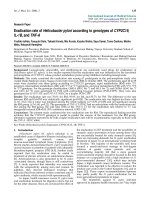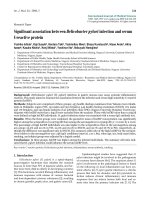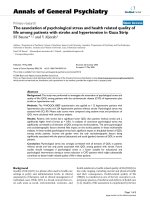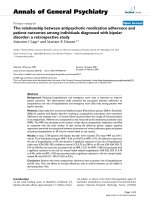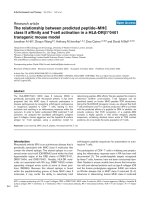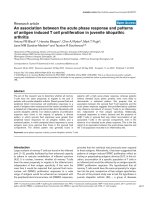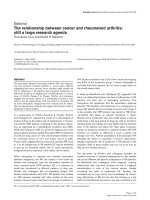Báo cáo y học: " Significant association between Helicobacter pylori infection and serum C-reactive protein" docx
Bạn đang xem bản rút gọn của tài liệu. Xem và tải ngay bản đầy đủ của tài liệu tại đây (334.3 KB, 6 trang )
Int. J. Med. Sci. 2008, 5
224
International Journal of Medical Sciences
ISSN 1449-1907 www.medsci.org 2008 5(4):224-229
© Ivyspring International Publisher. All rights reserved
Research Paper
Significant association between Helicobacter pylori infection and serum
C-reactive protein
Yoshiko Ishida
1
, Koji Suzuki
2
, Kentaro Taki
3
, Toshimitsu Niwa
3
, Shozo Kurotsuchi
4
, Hisao Ando
5
, Akira
Iwase
6
, Kazuko Nishio
1
, Kenji Wakai
1
, Yoshinori Ito
1
, Nobuyuki Hamajima
1
1. Department of Preventive Medicine/Biostatistics and Medical Decision Making, Nagoya University Graduate School of
Medicine, Nagoya, Japan
2. Department of Public Health, Fujita Health University School of Health Sciences
3. Department of Clinical Preventive Medicine, Nagoya University Graduate School of Medicine, Nagoya, Japan
4. Department of Obstetrics and Gynecology, Toyota Kosei Hospital, Toyota, Japan
5. Center for Reproductive Medicine, Toyohashi Municipal Hospital, Toyohashi, Japan.
6. Department of Obstetrics and Gynecology and Department of Maternal and Perinatal Medicine, Nagoya University
Graduate School of Medicine, Nagoya, Japan.
Correspondence to: Ms. Yoshiko Ishida, Department of Preventive Medicine / Biostatistics and Medical Decision Making, Nagoya Uni-
versity Graduate School of Medicine, 65 Tsurumai-cho, Showa-ku, Nagoya 466-8550 Japan, TEL:+81-52-744-2132,
FAX:+81-52-744-2971, e-mail:
Received: 2008.05.09; Accepted: 2008.07.23; Published: 2008.07.24
Background: Helicobacter pylori (H. pylori) infection in gastric mucosa may cause systemic inflammatory
reaction. This study aimed to examine the association between the infection and serum high sensitivity C-reactive
protein (hsCRP).
Methods: Subjects were comprised of three groups; 453 health checkup examinees from Yakumo town inhabi-
tants in Hokkaido, Japan (YTI, 153 males and 300 females), 449 health checkup examinees (ENUH, 273 males
and 176 females), and 255 female patients of an infertility clinic (PIC), Nagoya University Hospital. Twenty par-
ticipants with hsCRP more than 1 mg/dl were excluded from the analysis. Those with hsCRP more than 0.1mg/dl
were defined as high hsCRP individuals. H. pylori infection status was examined with a serum IgG antibody test.
Results: When the three groups were combined, the geometric mean of hsCRP concentration was significantly
higher among the seropositives (0.047mg/dl) than among the seronegatives (0.035mg/dl); p<0.0001 by a t-test.
The percentage of high hsCRP individuals was also higher in the seropositives than in the seronegatives among
any group; 23.3% and 20.1% in YTI, 22.0% and 16.0% in ENUH, and 32.7% and 18.7% in PIC, respectively, al-
though the difference was significant only in ENUH. The summary odds ratio of the high hsCRP for the seroposi-
tives relative to the seronegatives was 1.38 (95% confidence interval, 1.01-1.89), when age, sex, body mass index,
smoking, and subject group were adjusted by a logistic model.
Conclusions: In three groups, hsCRP was higher among the infected individuals. The summary odd ratio indi-
cated that H. pylori infection could influence the serum hsCRP level.
Key words: C-reactive protein, Helicobacter pylori infection, inflammation, serum antibody, smoking
1. Introduction
Helicobacter pylori (H. pylori) is a spiral-shaped,
gram-negative bacterium that inhabits the stomach
mucosa in more than 50% of Japanese adults, and fur-
ther more from child to elderly in developing countries
[1]. This bacterium can elicit lifelong inflammatory and
immune responses with release of various bacterial
and host-dependent cytotoxic substances [2], resulting
in chronic gastritis, peptic ulcer, and gastric cancer [3].
Epidemiological studies have suggested that H.
pylori infection might be involved in the pathogenesis
of coronary heart disease [4-6]. The suspicion about H.
pylori involvement in the pathological lesions is based
on the following: (i) local inflammation can have sys-
temic effects; (ii) H. pylori gastric infection is a chronic
process that lasts for decades; and (iii) persistent in-
fection induces chronic inflammatory and immune
responses that can induce lesions both local and re-
mote sites from the primary infection site [7, 8]. The
Int. J. Med. Sci. 2008, 5
225
manifestation may be caused by potential mechanisms
with direct or indirect actions [9]. The direct effects on
the vascular wall could include endothelial injury and
dysfunction through circulating endotoxins, smooth
muscle proliferation, and local inflammation. The in-
direct effects are more often pronounced, including
elevation of inflammatory mediators with proinflam-
matory, procoagulant, and atherogenic action, pro-
duction of cross-reactive antibodies, as well as nutri-
ent/vitamin malabsorption and metabolic distur-
bances such as overproduction of ammonia by the
bacterium.
C-reactive protein (CRP) is an acute-phase reac-
tant that originates from the liver. CRP has many
clinical and biological effects and can be used for the
diagnosis and follow-up of various inflammatory and
traumatic processes [10]. There is strong evidence that
CRP is a powerful predictor of incident cardiovascular
events independent of levels of LDL cholesterol, all
levels of the Framingham risk score, and the metabolic
syndrome [11-19]. The basal CRP level in individuals
free from acute illness is reproducible [20]. Its deter-
minants reportedly include age and smoking [21],
while substantial heritability (35–40%) was also re-
ported in familial aggregation studies [22].
Examining the association between H. pylori in-
fection and serum CRP levels seemed important to
elucidate the relevance of H. pylori infection with
coronary heart disease, especially atherosclerosis. The
previous studies on the association, however, pro-
vided inconsistent results [23, 24]. This study aimed to
examine the association in three different Japanese
groups.
2. Subjects and methods
Study subjects
The first group (YTI) was 524 apparently healthy
inhabitants, who attended a health check-up at Ya-
kumo town, Hokkaido, Japan in 2006. Among them,
505 agreed to participate in the study with written
informed consent. Lifestyle data collected with a
self-administered questionnaire, as well as residual
blood samples, were available from 459 subjects. Six
subjects with serum high-sensitivity CRP (hsCRP) > 1
mg/dl were excluded from the analysis, because they
might have an inflammatory disease. Remaining 453
subjects (153 males and 300 females) aged from 39 to 90
years were used for the present study.
The second group (ENUH) incorporated health
checkup examinees at Department of Clinical Preven-
tive Medicine, Nagoya University Hospital, who vis-
ited the department between June 2003 and February
2004. After the explanation of the study, 476 agreed
lifestyle questionnaire and donation of 7ml peripheral
blood for research purposes. Among them, 453 sub-
jects could determine the presence of H. pylori infection
and measure the hsCRP. Those with hsCRP more than
1 mg/dl were also excluded, remaining 449 subjects
(273 males and 176 females) aged from 17 to 89 years
for the present study.
The third group (PIC) consisted of 264 female pa-
tients at an infertility clinic, who underwent treatment
for infertility at Department of Obstetrics and Gyne-
cology or Department of Maternal and Perinatal
Medicine, Nagoya University Hospital between Feb-
ruary 2001 and December 2004. Stored blood samples
of the patients were available for research purposes.
Those with hsCRP more than 1 mg/dl were similarly
excluded, remaining 255 females aged from 21 to 48
years. All the three studies were approved by the Eth-
ics Committee of Nagoya University School of Medi-
cine (approval number 398, 52, 278 for YTI, ENUH and
PIC, respectively).
Determination of serum H. pylori infection and hsCRP
value
Sera were separated from blood samples imme-
diately after blood draw. They were kept in a deep
freezer at -80 ºC until analyses. A commercially avail-
able direct ELISA kit (“E Plate ‘Eiken’ H. pylori Anti-
body” from Eiken Kagaku, Tokyo, Japan) was used to
determine the presence of H. pylori infection. The
seropositive was defined as H. pylori IgG antibody
more than 10 U/ml. The hsCRP was measured with a
particle-enhanced immunoturbidometric latex agglu-
tination assay by SRL Co. Ltd., Tokyo. The assay could
detect 0.004 mg/dl of CRP. Undetectable CRP values
were recorded as 0.002 mg/dl. The staff in the labora-
tory was blinded to the seropositivity of H. pylori an-
tibody.
Statistical analysis
The difference in geometric mean of serum
hsCRP between H. pylori positive subjects and negative
subjects was statistically tested with a t-test, because
log
e
-transformed hsCRP distributed symmetrically
with one peak. Participants with hsCRP more than 0.1
mg/dl were defined as high hsCRP individuals in this
study. The proportion of high hsCRP subjects was
compared between the seropositives and the sero-
negatives with a Fisher’s exact test. Odds ratios (ORs)
and 95% confidence intervals (CIs) of the seropositives
compared with the seronegatives for high hsCRP were
calculated using unconditional logistic regression
models, adjusting for age (<30, 30-39, 40-49, 50-59,
60-69, or ≧70 years), sex, body mass index (BMI) (<25,
or ≧25kg/m
2
), smoking (never, former, current, or
unknown), and study group. The heterogeneity in the
OR among study groups was tested with the Q statis-
Int. J. Med. Sci. 2008, 5
226
tic. The data were analyzed by the statistical software
“STATA/SE version 9.0” (College Station, TX, USA).
3. Results
The sex, age, hsCRP level, BMI, and smoking
habits of the participants according to the study group
are summarized in Table 1. In YTI, females were
dominant (66.2%), and 65.3% were participants aged
60 years or older. In ENUH, males were dominant
(60.8%), and age was distributed over a wider range.
PIC was the group of only females aged under 50
years, because they were sampled from patients of an
infertility clinic. The hsCRP distributed from unde-
tectable level close to 1 mg/dl in any group, and the
frequency of high hsCRP individuals was comparable
among the three groups. The prevalence of H. pylori
infection in YTI was 62.1% (95/153) in males and 54.7%
(164/300) in females, 39.9% (109/273) and 36.9%
(65/176) in ENUH, respectively, and 20.4% (52/255) in
PIC. In total, the prevalence was 47.9% (204/426) in
males and 38.4% (281/731) in females.
Table 1 Characteristics of subjects from three study groups
YTI* ENUH
†
PIC
‡
Total
Characteristics (n=453) (n=449) (n=255) (n=1,157)
Sex
Males 153 (33.8) 273 (60.8) 0 ( 0.0) 426 (36.8)
Females 300 (66.2) 176 (39.2) 255 (100.0) 731 (63.2)
Age (years)
19-29 0 ( 0.0) 19 ( 4.2) 53 (20.8) 72 ( 6.2)
30-39 5 ( 1.1) 97 (21.6) 177 (69.4) 279 (24.1)
40-49 34 ( 7.5) 111 (24.7) 25 ( 9.8) 170 (14.7)
50-59 118 (26.0) 116 (25.8) 0 ( 0.0) 234 (20.2)
60-69 171 (37.7) 80 (17.8) 0 ( 0.0) 251 (21.7)
≧70 125 (27.6) 26 ( 5.8) 0 ( 0.0) 151 (13.1)
BMI (kg/m
2
)
<25 296 (65.3) 358 (79.7) 0 ( 0.0) 654 (56.5)
≧25 157 (34.7) 91 (20.3) 0 ( 0.0) 248 (21.4)
Unknown 0 ( 0.0) 0 ( 0.0) 255 (100.0) 255 (22.1)
hsCRP (mg/dl)
≦0.1 354 (78.1) 370 (82.4) 200 (78.4) 924 (79.9)
>0.1 99 (21.9) 79 (17.6) 55 (21.6) 233 (20.1)
Geometric mean 0.047 0.038 0.038 0.040
1st-3rd quartile 0.022-0.090 0.019-0.072 0.011-0.076 0.018-0.082
Range 0.002-0.973 0.002-0.923 0.002-0.994 0.002-0.994
Smoking
Never 280 (61.8) 230(51.2) 0 ( 0.0) 510 (56.7)
Former 97 (21.4) 126 (28.1) 0 ( 0.0) 223 (24.8)
Current 76 (16.8) 91 (20.3) 0 ( 0.0) 167 (18.6)
Unknown 0 ( 0.0) 2 ( 0.5) 255 (100.0) 257 (22.2)
YTI
*
: Yakumo Town Inhabitants, ENUH
†
: Examinees of Nagoya
University Hospital, PIC
‡
: Patients of Infertility Clinic, Nagoya Uni-
versity Hospital.
Percentages are shown in parentheses.
Table 2 shows associations of categorized hsCRP (
≦0.1 mg/dl or >0.1 mg/dl) with background factors.
In YTI, ENUH and whole participants, no significant
difference was found in the prevalence of hsCRP be-
tween sexes, although the high hsCRP was more
prevalent in males of YTI and in females of ENUH.
There was no significant difference in the hsCRP level
across age groups. The geometric mean of hsCRP level
was 0.051 mg/dl for H. pylori positive subjects and
0.042 mg/dl for H. pylori negative subjects in YTI, 0.043
mg/dl and 0.036 mg/dl in ENUH, 0.045 mg/dl and
0.028 mg/dl in PIC, respectively. Corresponding
1st-3rd quartile was 0.025-0.094 and 0.020-0.082 in YTI,
0.023-0.072 and 0.018-0.071 in ENUH, and 0.016-0.143
and 0.010-0.061 in PIC. In total, the geometric mean of
hsCRP level was 0.047mg/dl for H. pylori positive
subjects and 0.035mg/dl for H. pylori negative subjects,
with the 1st-3rd quartile of 0.023-0.093 and 0.015-0.073,
respectively. The hsCRP geometric mean was signifi-
cantly higher in subjects with H. pylori positive subjects
than in those without (p<0.0001 by a t-test).
In PIC, the high hsCRP level was observed more
frequently among subjects with H. pylori infection than
among those without it, with a statistically significant
difference; 32.7% vs. 18.7%, p=0.037 (Table 3). A simi-
lar difference in the prevalence of high hsCRP level
was also detected in the pooled population (23.5% vs.
17.7%, p=0.017). In YTI and ENUH groups, the pro-
portion of high hsCRP level was similarly higher in
those with H. pylori infection compared with those
without it, but the difference was not significant;
p=0.491 for YTI and p=0.127 for ENUH.
Table 3 also shows OR and 95% CI of H. pylori
seropositivity for the high hsCRP. The ORs were 1.18
(95% CI, 0.74-1.90) in TYI, 1.37 (95% CI, 0.81-2.31) in
ENUH, and 2.20 (95% CI, 1.11-4.37) in PIC, after ad-
justment for age, sex, BMI, and smoking habits. The Q
test for heterogeneity showed the differences in the OR
among the three groups was not significant (p=0.337).
The summary OR was 1.38 (95% CI, 1.01-1.89), with
allowance for study groups; 1.20 (95% CI, 0.73-1.95) in
males and 1.61 (95% CI, 1.09-1.38) in females. Because
the median of the age in pooled data was 52, we di-
vided the data into two groups at the age; the younger
group (age≦52 years) and the older group (age>52
years). The summary OR of the younger group ad-
justed for sex, BMI, smoking, and subject groups was
1.60 (95% CI, 1.00-2.55), while the corresponding OR of
the older group was 1.27 (95% CI, 0.85-1.90).
Int. J. Med. Sci. 2008, 5
227
Table 2 Associations between the serum level of hsCRP and background factors
YTI* ENUH
†
PIC
‡
Total
(n=453) (n=449) (n=255) (n=1,157)
Characteristics Low
§
High
‖
Low
§
High
‖
Low
§
High
‖
Low
§
High
‖
Sex
Males 111 (72.5) 42 (27.5) 228 (83.5) 45 (16.5) 0 ( 0.0) 0 ( 0.0) 339 (79.6) 87 (20.4)
Females 243 (81.0) 57 (19.0) 142 (80.7) 34 (19.3) 200 (78.4) 55 (21.6) 585 (80.0) 146 (20.0)
p-value
¶
0.054 0.449 - 0.879
Age (year)
19-29 0 ( 0.0) 0 ( 0.0) 17 (89.5) 2 (10.5) 39 (73.6) 14 (26.4) 56 (77.8) 16 (22.2)
30-39 5 (100.0) 0 ( 0.0) 82 (84.5) 15 (15.3) 140 (79.1) 37 (20.9) 227 (81.4) 52 (18.6)
40-49 29 ( 85.3) 5 (14.7) 94 (84.7) 17 (15.3) 21 (84.0) 4 (16.0) 144 (84.7) 26 (15.3)
50-59 97 ( 82.2) 21 (17.8) 93 (80.2) 23 (19.8) 0 ( 0.0) 0 ( 0.0) 190 (81.2) 44 (18.8)
60-69 130 ( 76.0) 41 (24.0) 63 (78.8) 17 (21.2) 0 ( 0.0) 0 ( 0.0) 193 (76.9) 58 (23.1)
≧70 93 ( 74.4) 32 (25.6) 21 (80.8) 5 (19.2) 0 ( 0.0) 0 ( 0.0) 114 (75.5) 37 (24.5)
p-value
¶
0.371 0.793 0.575 0.255
BMI (kg/m
2
)
<25 249 (84.1) 47 (15.9) 302 (84.4) 56 (15.6) 0 ( 0.0) 0 ( 0.0) 551 (84.3) 103 (15.8)
≧25 105 (66.9) 52 (33.1) 68 (74.7) 23 (25.3) 0 ( 0.0) 0 ( 0.0) 173 (69.8) 75 (30.2)
Unknown 0 ( 0.0) 0 ( 0.0) 0 ( 0.0) 0 ( 0.0) 200 (78.4) 55 (21.6) 200 (78.4) 55 (21.6)
p-value
¶
<0.001 0.044 - <0.001
Smoking
Never 225 (80.4) 55 (19.6) 190 (82.6) 40 (17.4) 0 ( 0.0) 0 ( 0.0) 415 (81.4) 95 (18.6)
Former 73 (75.3) 24 (24.7) 103 (81.8) 23 (18.3) 0 ( 0.0) 0 ( 0.0) 176 (78.9) 47 (21.1)
Current 56 (73.7) 20 (26.3) 75 (82.4) 16 (17.6) 0 ( 0.0) 0 ( 0.0) 131 (78.4) 36 (21.6)
Unknown 0 ( 0.0) 0 ( 0.0) 2 (100.0) 0 ( 0.0) 200 (78.4) 55 (21.6) 202 (78.6) 55 (21.4)
p-value
¶
0.324 0.990 - 0.589
Total 354 (78.1) 99 (21.9) 370 (82.4) 79 (17.6) 200 (78.4) 55 (21.6) 924 (79.8) 233 (20.1)
YTI
*
: Yakumo Town Inhabitants, ENUH
†
: Examinees of Nagoya University Hospital,
PIC
‡
: Patient of Infertility Clinic, Nagoya Unversity
Hospital, Low
§
: hsCRP≦0.1mg/dl,
High
‖
: hsCRP>0.1mg/dl, and p-value
¶
: Fisher’s exact test.
Percentages are shown in parentheses.
Table 3 Associations of the serum level of hsCRP with H. pylori seropositivity and odds ratio (OR) and 95% confidence interval
(CI) of H. pylori for hsCRP
H. pylori Low
*
High
†
OR (95% CI) aOR
‡
(95% CI) aOR
§
(95% CI)
YTI
‖
Seronegative 155 (79.9) 39 (20.1) 1 [Reference] 1 [Reference] 1 [Reference]
n=453 Seropositive 199 (76.8) 60 (23.2) 1.20 [ 0.76-1.89] 1.13 [ 0.71-1.79] 1.18 [ 0.74-1.90]
ENUH
¶
Seronegative 220 (84.0) 42 (16.0) 1 [Reference] 1 [Reference] 1 [Reference]
n=449 Seropositive 131 (78.0) 37 (22.0) 1.49 [ 0.92-2.44] 1.38 [ 0.83-2.32] 1.37 [ 0.81-2.31]
PIC
**
Seronegative 165 (81.4) 38 (18.7) 1 [Reference] 1 [Reference] 1 [Reference]
n=255 Seropositive 35 (67.3) 17 (32.7) 2.11 [ 1.07-4.16] 2.20 [ 1.11-4.37] -
Pooled
††
Seronegative 553 (82.3) 119 (17.7) 1 [Reference] 1 [Reference] 1 [Reference]
n=1,157 Seropositive 371 (76.5) 114 (23.5) 1.45 [ 1.07-1.97] 1.37 [ 1.01-1.86] 1.38 [ 1.01-1.89]
Low
*
: hsCRP≦0.1mg/dl, High
†
: hsCRP>0.1mg/dl,
‡
Sex-, and age-adjusted odds ratios (aOR
‡
),
§
Sex-, age- smoking- and BMI-adjusted odds
ratios (aOR
§
), YTI
‖
: Yakumo Town Inhabitants, ENUH
¶
: Examinees of Nagoya University Hospital, PIC
**
: Patients of Infertility Clinic, Nagoya
University Hospital, Pooled
††
: three studies were combined, and the ORs were adjusted additionally for the study groups using dummy
variables.
Percentages are shown in parentheses.
4. Discussion
The present paper examined the association of H.
pylori seropositivity with hsCRP in the range of 0.002 to
1.0 mg/dl, based on three different Japanese groups
with 1,157 subjects in total. Although the background
of the three groups was different, the sex, age, BMI,
and smoking adjusted OR of the seropositive for
hsCRP > 0.1 mg/dl relative to hsCRP ≦ 0.1 mg/dl
was larger than unity in all three groups. The sum-
mary OR was 1.38 (95% CI, 1.01-1.89), indicating that
H. pylori seropositivity was associated with a higher
hsCRP among those with hsCRP ≦ 1 mg/dl. We
tested the heterogeneity of the OR for high CRP levels
in relation to the seropositivity among three groups.
Because no significant differences in the OR were
found among study groups, we pooled the data de-
rived from three different populations.
Although H. pylori infection is associated with
coronary artery disease, the pathway to elevate the
disease risk is not clear. There are several possibilities
for the mechanism underlying a causal role of H. pylori
Int. J. Med. Sci. 2008, 5
228
infection in endothelial dysfunction. First, H. pylori
may have the direct effect on the structure and func-
tion of vascular endothelial cells. Extract of H. pylori
has been reported to induce a disturbance of prolifera-
tion and apoptosis and to decrease viability of cultured
vascular endothelial cells [25]. The second possibility is
the nutritional effect of H. pylori [26]. An infection from
H. pylori may cause malabsorption of folate, vitamin
B6, and vitamin B12. This nutritional defect could lead
to failure of methylation by 5-methyl-tetrahydrofolic
acid and subsequent hyperhomocysteinanemia, which
is toxic to endothelial cells. In our past study, serum
folate was examined as a molecule connecting H. pylori
infection with systemic diseases, resulting in no asso-
ciation between the seropositivity and serum folate
[27]. CRP is also one of the candidate molecules, but
there were limited reports on the association with H.
pylori infection.
A study on the effects of H. pylori eradication
among 78 patients in Turkey reported that serum CRP
was significantly reduced among 57 participants with
successful eradication, but not among 21 participants
in whom the eradication failed [23]. Another study
reported that increasing age, smoking, symptoms of
chronic bronchitis, H. pylori and Chlamydia pneumo-
niae infections, and BMI were all associated with
raised concentrations of CRP [24]. The present study
demonstrated that H. pylori infection may slightly ele-
vate serum CRP, thereby may increase systemic dis-
ease risk.
CRP is an easily measurable substance in blood.
Increased levels of this protein indicate acute inflam-
mation. Many studies have shown that high levels of
CRP also indicate an increased risk of suffering from a
heart attack or stroke. The CRP test is not specific, and
the levels fluctuate daily and throughout the day. The
levels increase as a result of numerous factors includ-
ing aging, alcohol use, smoking, eating a high protein
diet, coffee consumption, low levels of physical activ-
ity, chronic fatigue, high blood pressure, BMI, high
triglycerides, rheumatoid arthritis, rheumatic fever,
insulin resistance and diabetes [28], as well as heart
attack. Medicines containing estrogen (oral contracep-
tive and hormone replacement therapy) may also ele-
vate CRP levels. In this study, we took factors, sex, age,
BMI, and smoking into account, although information
on BMI and smoking was not available for PIC group.
Among the female subjects, smokers and fatty ladies
were relatively rare.
The present study has several limitations. First, H.
pylori infection was determined by only serum anti-
body, not by the other diagnosis methods with a
higher sensitivity and specificity, such as a urease
breath test. Since the present analysis was based on
stored blood samples from multi-purpose studies, al-
ternative methods could not be applied for the detec-
tion of H. pylori infection. Second, the information on
the other factors that affect serum CRP level was not
available. For example, chronic infections other than H.
pylori could confound the association with H. pylori
infection, since it seemed plausible that H. pylori in-
fected individuals might be vulnerable to other infec-
tions which elevate CRP. The adjustments of the po-
tential confounding factors might not be enough to
confirm the association with H. pylori infection. Third,
this study was a cross-sectional study so that the
causal inference was not possible directly. Finally, the
effects of medication on CRP were not removed. Since
several drugs, such as statins, were reported to influ-
ence CRP levels [29, 30], the adjustment for such
medications could allow clear interpretation on the
observed association.
If H. pylori has effects on the function of vascular
endothelial cells, serum CRP could be one of the
molecules to connect both. H. pylori infection stimu-
lates the production of proinflammatory cytokines
such as tumor necrosis factor (TNF), interleukin (IL) -6,
and IL-8 [31, 32]. H. pylori was detected not only in
gastric mucosa but also in human atherosclerotic
plaque [33, 34], and the expression of intercellular ad-
hension molecule-1 was higher in plaques containing
H. pylori than in those without it [33]. The production
of CRP is regulated by cytokines, principally inter-
leukins [35, 36], whose effects are modified by other
cytokines and growth factors [37], as well as by hor-
mones such as cortisol and insulin [38]. Production of
cytokines and stress hormones may be altered in con-
ditions other than inflammation or injury. TNF-α is a
potent inducer of IL-6 by various cells. Therefore, the
association of CRP concentration with H. pylori infec-
tion could be explained by the actions of cytokines,
hormones, or both.
In conclusion, the present cross-sectional study
based on the three different subjects showed a signifi-
cant association between H. pylori infection and serum
hsCRP levels, supporting that H
. pylori infection may
increase the serum CRP. The possible attribution of H.
pylori infection to CRP elevation could be a route to H.
pylori negative subjects related coronary heart disease
with the base of atherosclerosis. Since many factors
influence the CRP levels, larger studies with informa-
tion on potential confounding factors are necessary to
confirm the association.
Acknowledgments
The authors are grateful to Ms. Yoko Mitsuda for
their technical assistance. This work was supported in
part by a Grant-in-Aid for Scientific Research on Spe-
Int. J. Med. Sci. 2008, 5
229
cial Priority Areas of Cancer from the Ministry of
Education, Culture, Sports, Science and Technology of
Japan.
Conflict of Interest
The authors have declared that no conflict of in-
terest exists.
References
1. The EUROGAST Study Group. Epidemiology of, and risk factor
for, Helicobacter pylori infection among 3194 asymptomatic sub-
jects in 17 populations. Gut. 1993; 34: 1672-6.
2. Howden CW. Clinical expressions of Helicobacter pylori infection.
Am J Med. 1996; 20: 27S–32S.
3. Roussos A, Philippou N, Gourgoulianis KI. Helicobacter pylori
infection and respiratory diseases: a review. World J Gastroen-
terol. 2003; 9: 5–8.
4. Laurila A, Bloigu A, Nayha S, et al. Association of H. pylori in-
fection with elevated serum lipids. Atherosclerosis. 1999; 142:
207–10.
5. Kinjo K, Sato H, Sato H. Prevalence of H. pylori infection and its
link to coronary risk factors in Japanese patients with acute
myocardial infarction. Circ J. 2002; 66: 805–10.
6. Niemela S, Karttunen T, Korhonen T, et al. Could H. pylori in-
fection increase the risk of coronary heart disease by modifying
serum lipid concentrations? Heart. 1996; 75: 573–5.
7. Cammaroat G, Pasceri V, Gasbarrini A, et al. Helicobacter pylori is
an aetiologic factor for ischaemic heart disease: the case against.
Digest Liver Dis. 2000; 32: 65–8.
8. Realdi G, Dore PM, Fastame L. Extradigestive manifestations of
H. pylori infection. Fact and fiction. Dig Dis Sci. 1999; 44: 229–36.
9. Patel P, Gasbarrini G, Pretolani S, et al. Extradigestive diseases
and H. pylori infection. Curr Opin Gastroenterol. 1997; 13: 52–5.
10. Le Moullec JM, Jullienne A, Chenais J, et al. The complete se-
quence of human preprocalcitonin. FEBS Lett. 1984; 167: 93–7.
11. Ridker PM, Cushman M, Stampfer MJ, et al. Inflammation, as-
pirin, and the risk of cardiovascular disease in apparently
healthy men. N Engl J Med. 1997; 336: 973–9.
12. Ridker PM, Hennekens CH, Buring JE, et al. C-reactive protein
and other markers of inflammation in the prediction of cardio-
vascular disease in women. N Engl J Med. 2000; 342: 836–43.
13. Ridker PM, Rifai N, Rose L, et al. Comparison of C-reactive
protein and low-density lipoprotein cholesterol levels in the
prediction of first cardiovascular events. N Engl J Med. 2002;
347: 1557–65.
14. Paul MR, Julie EB, Nancy RC, et al. C-reactive protein, the
metabolic syndrome and risk of incident cardiovascular events.
Circulation. 2003; 107: 391–7.
15. Russell PT, Rozenn NL, Bruce MP, et al. Relationship of
C-reactive protein to risk of cardiovascular disease in the elderly:
results from the Cardiovascular Health Study and the Rural
Health Promotion Project. Arterioscler Thromb Vasc Biol. 1997;
17: 1121–7.
16. John D, Peter W, Mary W, et al. Low grade inflammation and
coronary heart disease: prospective study and updated
meta-analysis. BMJ. 2000; 321: 199–204.
17. Wolfgang K, Malte S, Margit F, et al. C-reactive protein, a sensi-
tive marker of inflammation predicts future risk of coronary
heart disease in initially healthy middle-aged men: results from
the MONICA (monitoring trends and determinants in cardio-
vascular disease) Augsburg Cohort Study, 1984 to 1992. Circu-
lation. 1999; 99: 237–42.
18. Kuller LH, Tracy
RP, Shaten J, et al. Relation of C-reactive pro-
tein and coronary artery heart disease in the MRFIT nested
casecontrol study: multiple risk factor intervention trial. Am J
Epidemiol. 1996; 144: 537–47.
19. Albert C, Ma J, Rifai N, et al. Prospective study of C-reactive
protein, homocysteine, and plasma lipid levels as predictors of
sudden cardiac death. Circulation. 2002; 105: 2595–9.
20. Pepys MB, Hirschfield GM. C-reactive protein: a critical update.
J Clin Invest. 2003; 111:1805–12.
21. Brian FM. Evidence of smoke and atherosclerotic fire. CCJM.
2001; 68: 538-40.
22. Mendall MA, Goggin PM, Molineaux N, et al. Relation of
Helicobacter pylori infection and coronary heart disease. Br Heart
J. 1994; 71: 437-39.
23. Suat S, Bekir K, Mustafa A, et al. Do procalcitonin and C-reactive
protein levels have a place in the diagnosis and follow-up of
Helicobacter pylori infections? J Med Microbiol. 2004; 53: 639-44.
24. Mendall MA, Praful P, Lydia B, et al. C Reactive protein and its
relation to cardiovascular risk factors: a population based cross
sectional study. BMJ. 1996; 312: 1061-5.
25. Kalia N, Jones C, Bardhan KD, et al. Effects of genotypically
different strains of Helicobacter pylori on human microvascular
endothelial cells in vitro. Dig Dis Sci. 2001; 46: 54-61.
26. Sung JJY, Sanderson JE. Hyperhomocysteinanemia, Helicobacter
pylori, and coronary heart disease. Heart. 1996; 76: 305-7.
27. Itou S, Goto Y, Kondo T, et al. Associations of methylenetetra-
hydrofolate reductase (MTHFR) polymorphism with hyperu-
ricemia in Japanese. Int J Med Sci. 2007; 4: 98-104.
28. Nanri A, Moore MA, Kono S. Impact of C-reactive protein on
disease risk and its relation to dietary factors: literature review.
Asian Pac J Cancer Prev. 2007; 8: 167-77.
29. Ridker PM, Cannon CP, Morrow D, et al. Pravastatin or Ator-
vastatin Evaluation and Infection Therapy−Thrombolysis in
Myocardial Infarction 22 (PROVE IT-TIMI 22) Investigators:
C-reactive protein levels and outcomes after statin therapy. N
Engl J Med. 2005; 352: 20-8.
30. Albert MA, Danielson E, Rifai N, et al. Effect of statin therapy on
C-reactive protein levels: the pravastatin inflammation/CRP
evaluation (PRINCE). a randomized trial and cohort study.
JAMA. 2001; 286: 64-70.
31. Crabtree JE, Shallcross TM, Heatley RV, et al. Mucosal tumour
necrosis factor alpha and interleukin-6 in patients with Helico-
bacter pylori associated gastritis. Gut. 1991; 32: 1473-7.
32. Moss SF, Legon S, Davies J, et al. Cytokine gene expression in
Helicobacter pylori associated antral gastritis. Gut. 1994; 35:
1567-70.
33. Farsak B, Yildirir A, Akyon Y, et al. Detection of Chlamydia
pneumoniae and Helicobacter pylori DNA in human atheroscle-
rotic plaques by PCR. J Clin Microbiol. 2000; 38: 4408-11.
34. Ameriso SF, Fridman EA, Leiguarda RC, et al. Detection of
Helicobacter pylori
in human carotid atherosclerotic plaques.
St
roke. 2001; 32: 385-91.
35. Cabana V, Siegel J, Sabesin S. Effects of the acute phase response
on the concentration and density distribution of plasma lipids
and apolipoproteins. J Lipid Res. 1989; 30: 39-49.
36. Gauldie J, Richards C, Northemann W, et al. IFNB2/BSF2/IL-6
is the monocyte-derived HSF that regulates receptor-specific
acute phase gene regulation in hepatocytes. Ann NY Acad Sci.
1989; 557: 46-59.
37. Mackiewicz A, Speroff T, Ganapathim M, et al. Effects of cyto-
kine combinations on acute phase protein production in two
human hepatoma cell lines. J Immunol. 1991; 146: 3032-7.
38. Baumann H, Gauldie J. The acute phase response. Immunol
Today. 1994; 15: 74-80.

